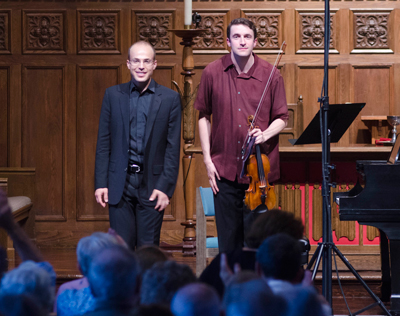By Daniel Hautzinger

Erwin Schulhoff was born in Prague in 1894. He was wounded in WWI while serving in the Austro-Hungarian military, and ended the war in an Italian POW camp. The first movement of his String Sextet was composed in Dresden in 1920, two years after the end of the war, the final three movements in Prague in 1924. It is an intense work, devoid of hope: the death and desolation of the war Schulhoff had just witnessed pervade every note. Violinists Yehonatan Berick and Amy Schwartz Moretti, violists Dimitri Murrath and Yura Lee, and cellists Julie Albers and Robert deMaine unflinchingly faced that darkness, giving a devastating performance in the deepening twilight of Fairmount (and receiving three standing ovations for their effort).
The first movement opens with a scene of bloody carnage, dissonant lines lashing against each other before weakening into wide-eyed delirium, themes wandering around in horror. The performers held the audience rapt in the remarkable second movement, their tone vibrato-less and ice-cold while playing obsessive figures. They sustained the funereal tension without break, sinking to the threshold of hearing before fading to silence. The third movement “Burlesca,” an unsettled danse macabre, contrasted with the slower final movement. The entire piece ends with a grim cello melody over a nearly inaudible drone. Comfort never arrives. Until after the intermission.
The next piece, Dvořák’s Piano Quartet No. 2 in E-flat major, op. 87, could not be more different from the Schulhoff. Written in 1889, at the height of the happily prosperous era of European history known as the Belle Époque, the quartet is radiant, blazing with the optimism of an age untainted by war, let alone a World War. It is populated by vivacious melodies, unassailably cheerful lilts, and a sentimental cello solo, beautifully played here by Julie Albers. Albers, along with violinist Noah Bendix-Balgley, violist Dimitri Murrath, and pianist Roman Rabinovich brought the requisite verve and joy to banish the lingering shadows of the Schulhoff and to send the audience away whistling Dvořák’s tunes.
Bendix-Balgley and pianist Orion Weiss opened the concert with Janáček’s Sonata for Violin and Piano, which fell somewhere between the extremes of Schulhoff’s pessimism and Dvořák’s optimism, having been composed in 1914 on the cusp of the Great War. The sonata is rhapsodic, with alternations between bucolic imitations of nature and rough-hewn, violent gestures. The unguarded melody of the second movement is a touching instance of peace, but the work ends uncertainly, with impassioned violin punches disrupting attempts at a calm theme on the piano. With his vibrant and focused playing, Weiss was the perfect partner to Bendix-Balgley’s hyper-attentive performance: every note was nuanced in dynamics and sound quality.
“Three Bouncing Czechs” proved that music can capture the psyche of a time in a way that words cannot, especially when the performers are able to express the ineffable sentiment that moves a piece. The musicians of ChamberFest were more than capable of such a feat.
Photos by Gary Adams.
Published on ClevelandClassical.com June 30, 2014.
Click here for a printable copy of this article.





